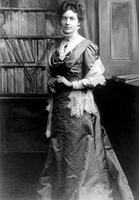Lorrie Alfreda Dunington-Grubb
Lorrie Alfreda Dunington-Grubb, née Dunington, landscape architect (b at England 1877; d at the Mountain Sanatorium, Hamilton 17 January 1945). Lorrie Dunington grew up in India, South Africa and Australia. She studied garden design at Swanley Horticultural College in England before opening an office in London and practising "throughout the British Isles."In 1911 she married Howard Grubb (see HowardDUNINGTON-GRUBB), adopting the surname Dunington-Grubb, and emigrated to Canada. In Toronto she worked on her own, and in partnership with her husband, on private and public garden designs, town planning projects and design of garden suburbs, and helped to start Sheridan Nurseries.
She lectured at the University of Toronto's Department of Social Service on the subject of housing and town planning and for the Ontario Department of Agriculture on the subject of city beautification. She wrote prolifically on garden design for MAGAZINES such as Canadian Homes and Gardens, Maclean's and Woman's Century, was active in Toronto arts and letters society, and volunteered time and expertise to a number of organizations. Her activities were curtailed after 1928 by tuberculosis, but she was a founding member of the Canadian Society of Landscape Architects in 1934, and president of the Society in 1944.
Lorrie Dunington-Grubb was one of the first women in Canada to practise professionally as a landscape architect. Noted for her contribution to the growth of urban planning, she was instrumental in gaining the collaboration of other artists, particularly sculptors, in the design of public spaces. Her style of design, her use of perennials and rock garden plants, and her emphasis on colour and texture provided a direct link with Gertrude Jekyll for Canadian gardens.
See alsoLANDSCAPE ARCHITECTURE.

 Share on Facebook
Share on Facebook Share on X
Share on X Share by Email
Share by Email Share on Google Classroom
Share on Google Classroom




